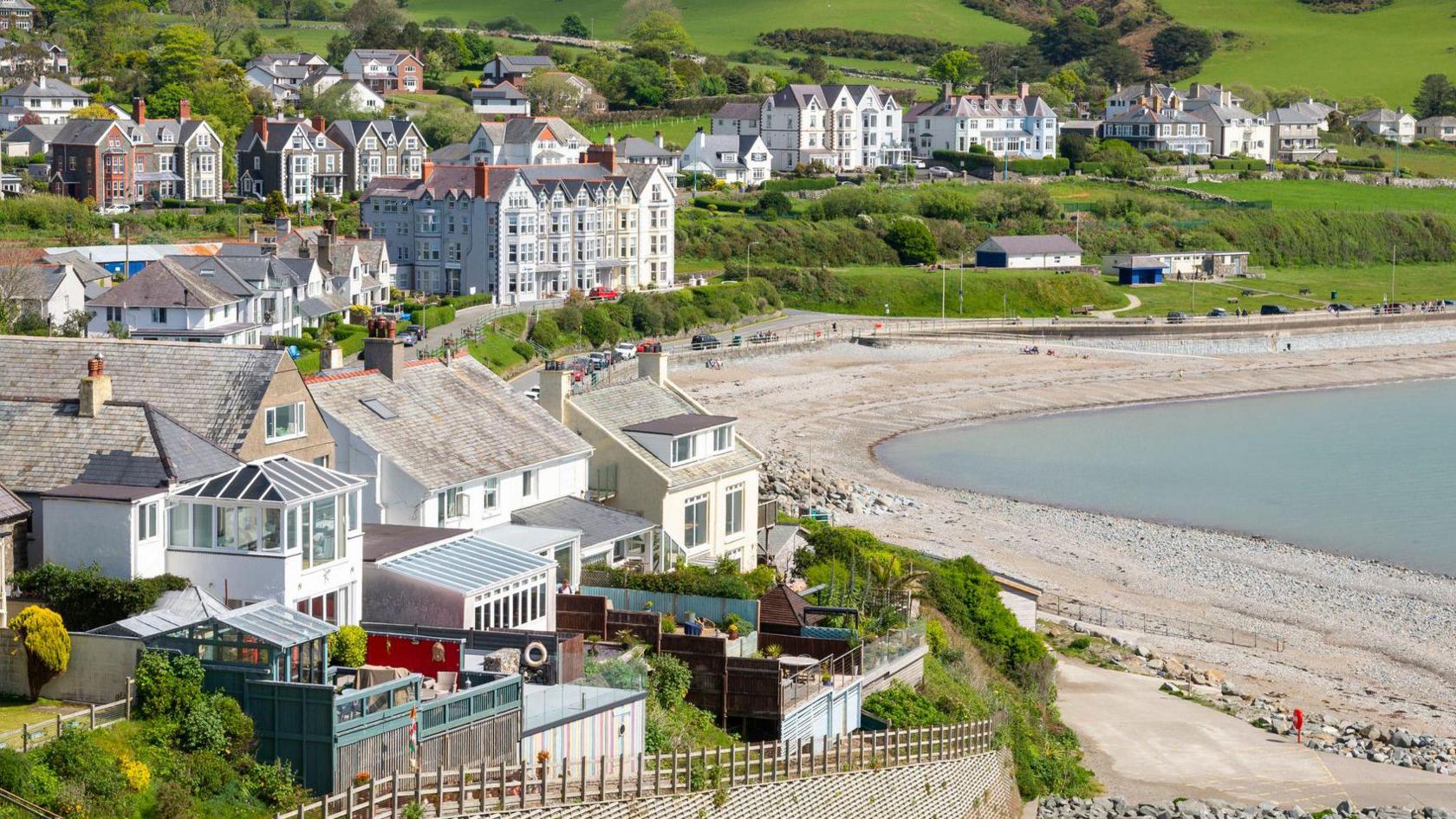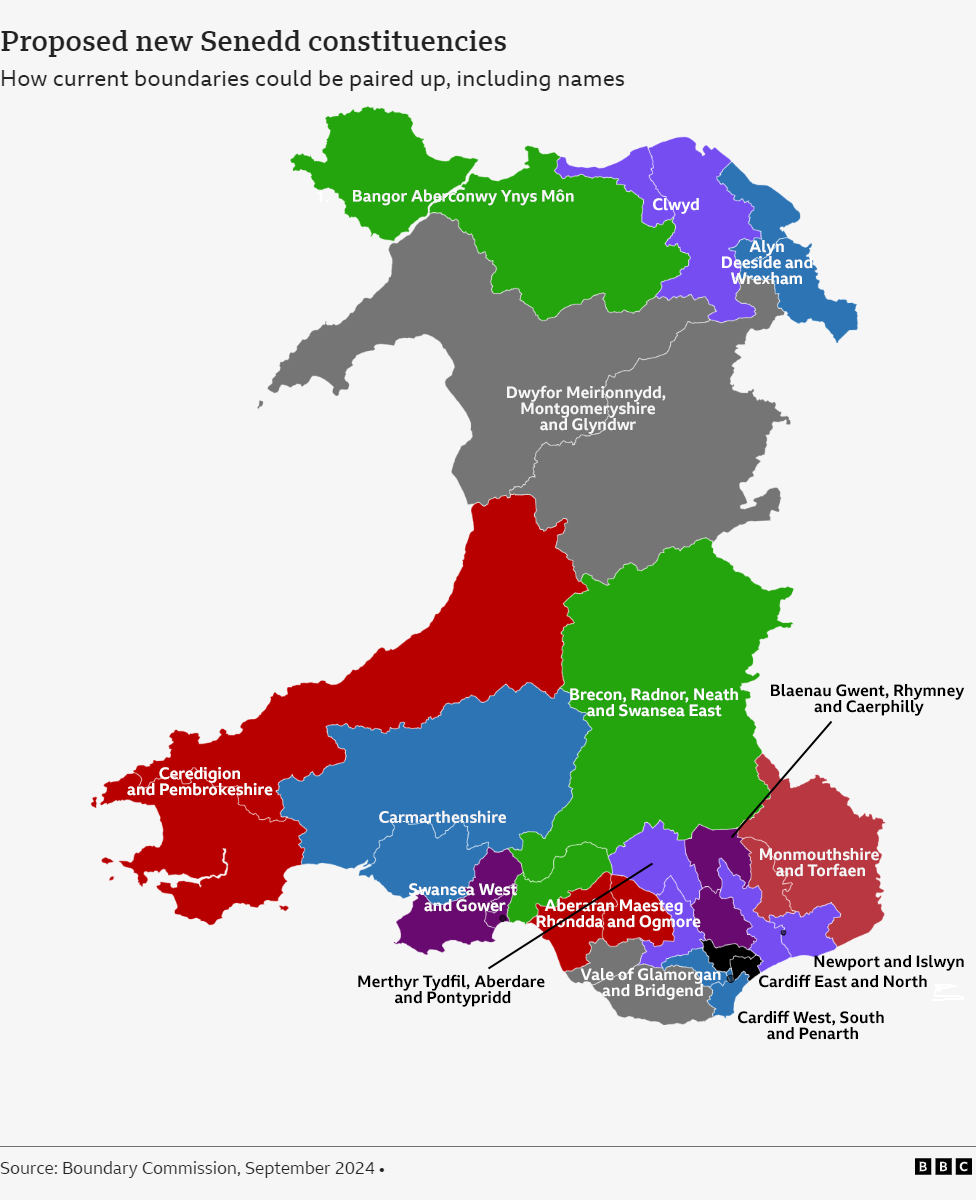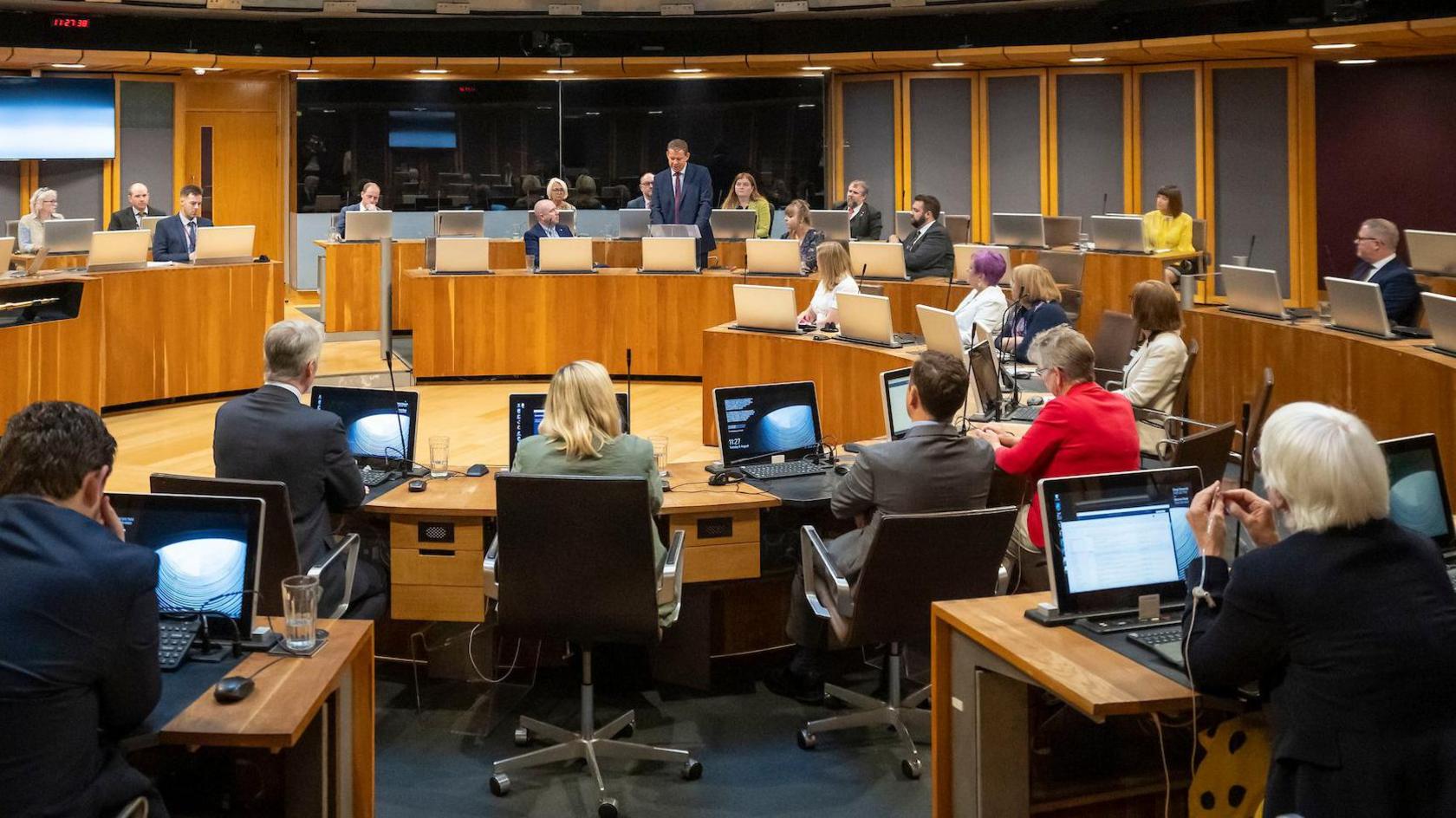Huge seat part of plans for more Senedd politicians

The largest new seat will stretch from the Llŷn Peninsula to the border with England
- Published
A constituency that stretches from the Llŷn Peninsula coastline to Wales' border with England is among the proposals for the next Senedd election in 2026.
From the next election, Wales will send 96 politicians to the Welsh Parliament - 36 more than now - with a new voting system that will have fewer and larger constituencies.
Boundary commissioners have now published proposals for how the seats could work - with the largest seat as big as 1,927 sq miles (4,992 sq km).
Created by pairing up Wales' 32 Westminster seats into 16 constituencies, the new boundaries cross many of the the country's existing administrative borders.
Former Plaid Cymru leader Lord Dafydd Wigley said he was "horrified" by the size of the new constituencies that had been recommended, questioning how a politician could represent such a big area.
A Liberal Democrat MP feared the proposals "will do little to rekindle people's falling faith in Welsh democracy".
But a Labour Senedd member said the pairings were "fairly predictable" and that the number of extra MSs will mean a "broader representation" in Cardiff Bay.
Commissioners urged the public to give their views in their consultation, which runs until 30 September.
They said they considered transport links, local ties, shared history, the Welsh language and other socio-economic considerations to "propose constituencies which feel as natural as possible".
Proposals will be revised again in December, and will be finalised next March.
The map is temporary, and the result of a system designed to be drawn up quickly for the next election in 2026.
There are plans to give a further review more time to draw up a fresh set of seats for the election after next in 2030, when the map is likely to be changed again with the commissioners given more flexibility.
Map of Welsh MPs seats redrawn as number cut to 32
- Published28 June 2023
The new constituencies in Wales and why they are changing
- Published1 July 2024
Plans for more Senedd politicians get go-ahead
- Published8 May 2024

The full list of seats
Bangor Aberconwy Ynys Môn
Clwyd (merged from Clwyd East and Clwyd North)
Alyn, Deeside and Wrexham
Dwyfor Meirionnydd, Montgomeryshire and Glyndŵr
Ceredigion and Pembrokeshire (merged from Ceredigion Preseli and Mid and South Pembs)
Carmarthenshire (merged from Caerfyrddin and Llanelli)
Swansea West and Gower
Brecon, Radnor, Neath and Swansea East (merged from Brecon, Radnor and Cwmtawe and Neath and Swansea East)
Aberafan Maesteg, Rhondda and Ogmore
Merthyr Tydfil, Aberdare and Pontypridd
Blaenau Gwent, Rhymney and Caerphilly
Monmouthshire and Torfaen
Newport and Islwyn (merged from Newport East and Newport West and Islwyn)
Cardiff East and North
Cardiff West, South and Penarth
Vale of Glamorgan and Bridgend
What is the new larger Senedd?
From 2026, the way the public votes for the Senedd will be totally reformed, abandoning the mixed system of first past the post and party lists that existed before.
Currently there are 60 Members of the Senedd (MSs), elected through a mix of 40 first past the post constituencies and lists in the five regions.
But under the new system, there will be 96 MSs, all voted via a system which aims to reflect better how people voted.
To achieve that, there will be 16 constituencies instead of the 40 there are now, electing six politicians each through party lists.
To get things ready quickly, with the next election less than two years away, without having to draw a map from scratch, each constituency will be formed by pairing up the 32 seats for Westminster.
The Westminster seats were themselves only drawn up in 2023, following a review that saw Wales lose eight seats with borders drawn larger to cover more equal numbers of people.

There will be more seats needed in the Senedd's debating chamber after the 2026 election
Why are some new Senedd seats so big?
The Democracy and Boundary Commission Cymru, external was given the task to find the pairings.
The only criteria it was given was that the two seats had to be "contiguous" - commissioners interpreted that as meaning there had to be a direct road link between them.
In rural areas where fewer people live, the new system also means that some constituencies are geographically large. More proportional voting systems also tend to require larger seats.
The largest geographical constituency is Dwyfor Meirionnydd, Montgomeryshire and Glyndŵr - a merger of the Westminster seats of the same names.
Six MSs will serve an area the size of 1,927 sq miles (4,992 sq km) - stretching from the Llŷn Peninsula in the west to the border with England, covering parts of the counties of Gwynedd and Powys.
The report by the commission admitted that it was "not ideal to propose such a large constituency".
But it said it was the "best option" available - saying the alternative of merging Dwyfor Meirionnydd with Ceredigion Preseli, and Montgomeryshire and Glyndŵr, would have created two "very large and unwieldly" constituencies.
Another large constituency is Ceredigion and Pembrokeshire - a merger of the Westminster seats of Ceredigion Preseli and Mid and South Pembrokeshire. It is 1,329 sq miles (3,444 sq km) in size.
More built-up areas are smaller - the smallest is Cardiff East and North, which covers some of the capital's most densely populated areas.

The location of the Britannia and Menai bridges means the commissioners have proposed linking Ynys Môn with Bangor Aberconwy
The requirement for a road to exist between two seats means that the Anglesey seat of Ynys Môn is being proposed for merger with Bangor Aberconwy because of the Menai crossings, as opposed to Dwyfor Meirionnydd.
The city of Newport will be in one constituency in Newport and Islwyn, albeit with part of the valley stretching to its north west.
Some of Wales' rural areas will share constituencies with the urban valleys - including Monmouthshire and Torfaen.
Carmarthenshire will be a seat to itself, merged from Caerfyrddin and Llanelli.
Meanwhile Brecon, Radnor and Cwm Tawe - which was controversial at the last boundary review because of the inclusion of the Swansea Valley with the rural Brecon and Radnorshire - will be paired with Neath and Swansea East.
The commission has used the names of the original Westminster seats where there is not a name in common use.
It is seeking comment from the public on its own proposed names - with the longest, Brecon, Radnor, Neath and Swansea East, stretching to six words.
The electorates likely to be similar in size, but not identical, in each constituency.
That's with the exception of Bangor Aberconwy Ynys Môn, however, because the small size of the Ynys Môn constituency was protected in the Westminister review, meaning the combined seat is likely smaller.
Why is Wales getting more politicians in the Senedd?
The map is all part of the plan to reform the Senedd and elect more politicians in Cardiff Bay, originally penned by former first minister Mark Drakeford and ex-Plaid Cymru leader Adam Price.
The Senedd - and the Welsh government which is formed from it - have more powers than the predecessor National Assembly to make laws and set taxes.
It's been a long standing complaint that the body is too small to cope with the task of scrutinising government, and needs to expand to reflect its responsibilities.
Welsh Labour and Plaid Cymru are both on board with the plan - but the Welsh Conservatives complained about the cost - an extra £18m a year on top of its £67m a year budget.
Some who support the principle of a larger Senedd are worried about the way it will be elected, though a system known as closed lists.
Voters will only be able to back a party, rather than a specific candidate - and there are concerns that will break the link between the electorate and the politicians themselves.
Prof Laura McAllister said the "closed lists" system would put too much power in the hands of parties, and could erode trust with the public.
There are plans for parties to be required to submit lists of candidates with at least 50% women, but they are delayed until the Senedd election in 2030.

Mark Drakeford drafted the original plans to expand the Senedd with former Plaid Cymru leader Adam Price when he was first minister
How will the new Senedd members be elected?
Voters will cast their votes to select a party list, rather than an individual candidate.
In the new large constituencies, six MSs will be elected.
A mathematical calculation called D'Hondt will be applied to the number of votes to decide who wins, and would be applied again and again until all the seats are allocated. The system was already used to decide who got the Senedd's regional spots.
The votes of all the parties are divided by the number of seats they have won at that point in the process, plus one. In the first instance, the party with the largest number of votes wins the first seat.
But after the first is handed out, D'Hondt starts to have an impact.
In an imaginary election where party A won 25,000 votes, party B won 15,000, and party C won 10,000, party A would win the first seat, and party B would win the second seat.
Party A would win the third seat, but party C would win the fourth.
Analysis
By Gareth Lewis, political editor
Wales’s electoral maps for Westminster elections and Senedd elections are now going to look radically different.
There have already been concerns that the size of the 16 new constituencies will dilute our sense of "belonging" and that six MSs per constituency might dilute our personal connection with our politicians.
This all comes at a time when the polls – and anecdotal conversations – suggest that we’re distinguishing more than ever before between what Westminster is in charge of and what the Senedd controls.
So depending on your point of view, it’s either an optimum or a risky time to make fundamental change.
One of the biggest tests of the new system might well be turnout. We have a new map, more MSs - and on current polling - electoral jeopardy for Labour, but will that see turnout over 50% in a Senedd election for the first time?
Reaction
Former Plaid Cymru leader Lord Dafydd Wigley questioned how one member could represent such a large area as the proposed Dwyfor Meirionnydd, Montgomeryshire and Glyndwr constituency.
"How on earth does one member represent an area from Bardsey island to the border of England," he asked.
"The purpose of having elected members of the Welsh Parliament is to represent those areas. And if there is a large area with such severe differences in its industry, in its language, in its culture and in its way of life, what is going to suffer the most is the countryside and I believe that is completely unacceptable."
Mick Antoniw, who helped get the legislation for the Senedd reforms through the Welsh Parliament when he was counsel general, said the map was "fairly predictable".
On BBC Radio Wales, the Labour MS for Pontypridd said the pairings make it "easier to introduce a higher level of diversity and gender balance" among the six Senedd members that will be elected from paired consistencies.
"It's one of the great difficulties in Wales because we have a very densely populated north and south, and we have this enormous rural area in the centre.
"We've always have had some constituencies that are absolutely enormous."
But he said with six representatives for each new constituency "it will be far more possible that there's more broader representation of those areas than perhaps there has been in the past".
'Wrong priority'
Welsh Conservative Shadow Minister for the Constitution Darren Millar said the expansion proposals were "the wrong priority".
"More boundary changes will cause yet further upheaval and confusion for those who have already had to contend with boundary changes in council and Westminster elections," he added.
David Chadwick, Liberal Democrat MP for Brecon, Radnor and Cwm Tawe, said: “I’m very concerned that these proposals will do little to rekindle people’s falling faith in Welsh democracy.
"Many communities won’t recognise themselves in these proposals."
A Plaid Cymru spokesperson said: "Moves to strengthen Welsh democracy are long overdue.
"From 2026, the people of Wales will be better represented, and the Welsh government can be more effectively scrutinised."
Reform UK, which has no Welsh seats in the Senedd or Westminster, is hoping the new Welsh Parliament will be an opportunity for the party.
“Today’s announcement is an exciting one for Reform UK," chairman Zia Yusuf said, adding the party was building a "local branch structure across the whole of Wales".
Chief executive of the commission, Shereen Williams, said: “We strongly encourage everyone to share their views with us, whether they support or oppose the proposals, so that we can go on to further strengthen the map ahead of the next election.”